What is the Oldest Continuous Horse Race in Kentucky
Kentucky is known around the world for many things — from KFC to Muhammad Ali — but the two biggest assets the commonwealth has become synonymous with are bourbon and horse racing. And believe it or not, both thrive in the area due to one common denominator: the natural limestone-filtered water that flows throughout Kentucky's 40,407 square miles. And just as the water flows strong, so does the history of horse racing in Kentucky.
Both commodities also began growing about the same time. As settlers pushed further and further west in the mid-18 th century, those with previous distilling knowledge and those with equestrian experience recognized Kentucky's wealth of limestone and mineral-based water. This water produces strong bones in horses and quality whiskey free from impurities.
So, many decided to settle in the area and either distill whiskey or breed and raise thoroughbreds. Thoroughbred racing was just ramping up on the East Coast during this time, and many farms throughout Kentucky would hold private races for those who lived nearby. Those small-town tracks eventually led to bigger and bigger courses, attracting people from near and far. And now, Kentucky reigns supreme when it comes to thoroughbred racing in the United States.
Just how big is the industry? According to statistics from the Kentucky Thoroughbred Association (KTA), the equine industry generates $6.5 billion in annual economic activity and provides more than 60,000 jobs in Kentucky. But before we dive into the thriving Kentucky horse racing and thoroughbred industry of today, let's take a quick look at some of the people and places responsible for Kentucky's renowned stature in horse-racing history.
William Whitley Sets the Pace for Kentucky Horse Racing
No discussion on Kentucky horse racing would be complete without a mention of William Whitley, a Revolutionary War hero who settled in the Kentucky town of Crab Orchard (Lincoln County) shortly before Kentucky became a state in 1792. He loved to race thoroughbreds on his farm, and so he built a private circular track he called Sportsman's Hill.
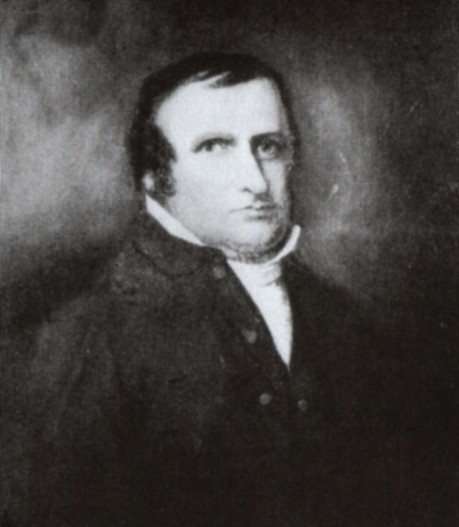
William Whitley
You see, while Whitley fended off the British during the war, he developed a hatred of anything associated with England. No queens, no kings, no palaces with funny-dressed guards, no 300-foot-tall clocks and definitely no horse racing — wait, Whitley loved horse racing, so instead of boycotting that hobby, he decided to change it.
According to "The Encyclopedia of Northern Kentucky," Whitley decided that his horses would race counterclockwise on dirt, as opposed to England's tradition of running horses clockwise on grass. These two major changes quickly became the "American way" to race thoroughbreds, and nearly all of the major American horse races today — including the Kentucky Derby — follow these two rules.
And speaking of the Kentucky Derby, Whitley's passion for horse racing and the excitement he cultivated at his Sportsman's Hill directly led to the creation of that famous race.
Always one to defend his country, Whitley answered the call of duty at 64 years old and fought in the Battle of Thames in 1813. He joined one of the five brigades of Kentucky militia involved in the War of 1812 against Tecumseh's Confederacy and — you guessed it — the British. Unfortunately, Whitley was a casualty in that battle and never made it home again.
However, horse racing continued at Sportsman's Hill well into the 1860s, putting Crab Orchard on the map. In fact, with an addition of the Crab Orchard Springs Hotel and another nearby racetrack built by Henry Farris, called Spring Hill Race Course, this area became known as the "Saratoga of the South" and attracted Southern socialites each summer.
It was at the newly built Spring Hill Race Course that the Crab Orchard Derby began, attracting hundreds of people each spring from around the area. The small town and the big race quickly grew in popularity each year, but the events and the tourism came to an abrupt halt when the Civil War began in 1861.
After the war was over, the town made an effort to harness the Crab Orchard Derby energy and keep it going, but that interest had long faded. Southern socialites no longer visited the area. In 1875, a similar race was held in Louisville in the spring, and it went by the name of the Kentucky Derby.
According to a historical marker now at Sportsman's Hill (courtesy of ExploreKYHistory ): Colonel John Chinn, breeder, author of "Kentucky Racing Regulations" and owner of the 1883 Kentucky Derby winner, Leonatus, stated: "When the South lost the Civil War, it wouldn't be farfetched to say that it lost the Derby to Louisville. What was the equivalent of the Derby before … was the Crab Orchard Derby."
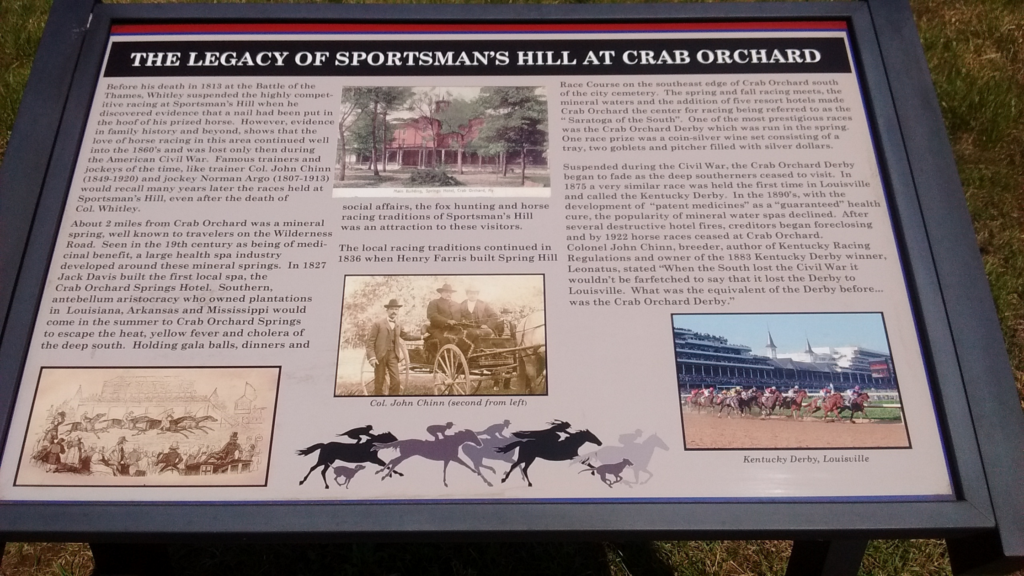
Courtesy of Explore KY History
Lexington: Lexington Association Horse Racing Track → Keeneland
Lexington has the honors of hosting the very first official thoroughbred race in Kentucky when the Lexington Association Track opened in 1828. According to VisitLex , it was the first racetrack to have a set of written rules and a governing board.
While the first racetrack in Lexington — and all of Kentucky for that matter — opened in 1789, it wasn't until the Lexington Association Track was built that the sport began to organize and start keeping records. Back then, horses actually outnumbered people in Lexington, and some folks would race horses on city streets — until the local government stepped in and outlawed that for safety reasons.
In 1875, another track was built in Lexington called The Red Mile , and this one was for harness racing and also a new breed of horse that was just coming onto the scene: the Standardbred . Just as its name implies, the track was a mile long in the shape of an oval and made with red clay. Still operating today, The Red Mile is the second-oldest harness track in the world.
In the 1930s, while the country was in the throes of the Great Depression, interest in the Lexington Association Track had slowed quite a bit, and the facility was closed for good. However, a group of local horsemen and businessmen decided to pick up the reins and open a new track that would serve as both a racing facility and an auction house for horses.
Enter Keeneland Race Course , which opened in 1936 and today is the largest thoroughbred auction house in the world. The modern track was built on 147 acres just west of Lexington, on farmland owned by Jack Keene, son of James R. Keene, a famous thoroughbred owner and breeder. There are just two live race meets at Keeneland each year, held in April and October, and annual attendance averages over 300,000. One of the most notable races held here is the Blue Grass Stakes, a prep race for the Kentucky Derby.
Also worth noting, Keeneland was ranked No. 1 of the Top 10 Tracks in America by the Horseplayers Association of North America in 2009.

Courtesy of Churhill Downs
Louisville: Louisville Jockey Club → Churchill Downs
In 1872, Meriwether Lewis Clark Jr. took a trip the opposite way of his famous grandfather, the William Clark of the Lewis & Clark expedition, traveling across the Atlantic to Europe.
Clark Jr. was a big horse-racing fan, so he timed his trip to make it to the Epsom Derby race in Surrey, England, which had been held there since 1780. Next, he jumped over to Paris, France, and met with some of the founders of the French Jockey Club, which had just organized the Grand Prix de Paris race.
He vowed to create something similar once he got back home, and in 1874 he created the Louisville Jockey Club and began work on a state-of-the-art racetrack in Louisville. Clark Jr. leased the 80 acres of land for the track from uncles John and Henry Churchill, so the name Churchill Downs seemed most appropriate.
On May 17, 1875, the first Kentucky Derby was held, attracting more than 10,000 spectators who cheered as Aristides crossed the finish line. Now, more than 160,000 people from all over the world travel to Kentucky to attend the Derby, and millions more watch it on television.
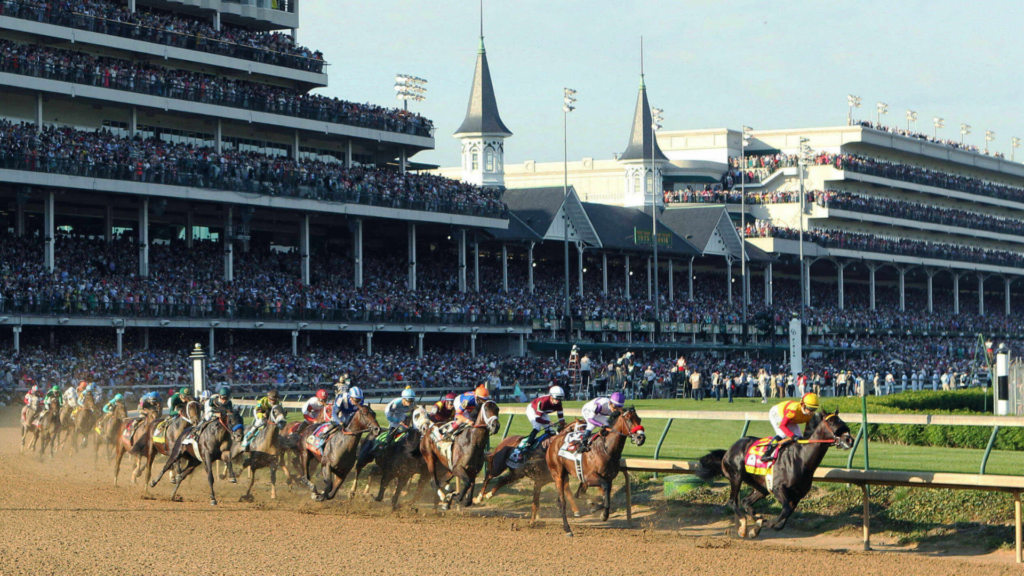
Courtesy of Churchill Downs
While Churchill Downs has changed hands throughout the years, the fervor for the Derby has never waned. Clark Jr. sold the track in 1894 to a syndicate led by William E. Applegate. Under his leadership, the organization shortened the length of the Derby from to 1½ miles to 1¼ miles and also constructed the famous twin spires atop the grandstand.
The track would switch hands again in 1902, as Applegate turned over the reins to Charles F. Grainger, who was mayor of Louisville at the time, and Col. Matt Winn, who further propelled the Kentucky Derby into the American sports psyche.
Here are some interesting facts and firsts about the Kentucky Derby:
- 13 of the 15 jockeys in the first Derby were black; black jockey Oliver Lewis won with Aristides in 1875.
- The red rose became the official flower of the Derby in 1904.
- The first filly, Regret, won the Derby in 1915.
- The first horse, Sir Barton, wins three consecutive races (Derby, Preakness, Belmont) in 1919 before the term "Triple Crown" was created.
- The first live radio broadcast of the Derby was in 1925.
- The Derby was permanently scheduled for the first Saturday in May in 1931 after being held on various dates in May.
- The Mint Julep became the official cocktail of the Derby in 1938, and now more than 120,000 are served each Oaks and Derby Day.
- The first local televised broadcast was in 1949.
- The first national televised broadcast was in 1952.
- The first female jockey, Diane Crump, raced in the Derby in 1970.
- The fastest time for a Derby horse was 1:59.97 by Secretariat in 1973.
- The Kentucky Derby is the oldest continuously held major sporting event in the United States.
If you're big into Derby talk, then you'll want to check out our guide to the Kentucky Derby. This guide explains the need to know about the Kentucky Derby — when, where, cost and of course, what to wear! In addition to these must know Derby day things, you may be asking yourself about what you can do during Derby week in Louisville. Mint Julep Experiences offers three popular Derby week tours — Best of Kentucky Tour, Bourbon Country Tour and a Horse Country Tour. Each of these tours will show you the heritage and key industries of Kentucky. You'll also get Derby and horse racing history along the way!
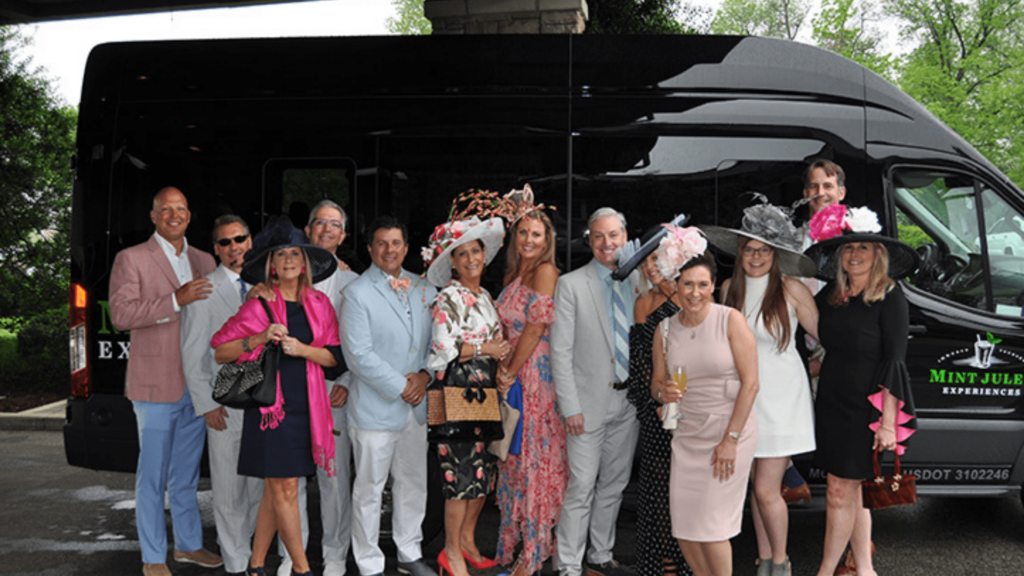
Northern Kentucky: Latonia Race Track → Turfway Park
With popular horse racing tracks in Lexington and Louisville, a group of horsemen in northern Kentucky decided they wanted in on the thoroughbred-racing action, too, so in 1883, the Latonia Race Track near Covington, Ky., opened with much fanfare. In fact, according to "The Encyclopedia of Northern Kentucky," more than 10,000 people showed up for that very first race.
The Latonia Race Track was beautiful and modern for the time, featuring an expansive white-and-green grandstand as well as a lake and flower garden. The big Kentucky horse race here was initially called the Hindoo Stakes and then renamed to the Latonia Derby in 1888, usually held six weeks after the Kentucky Derby.
Latonia thrived during the early 1900s, offering winnings much higher than at either racetrack in Lexington or Louisville. And between 1915 and 1928, it led all tracks in the country in total purse money awarded. In 1912, a movie called "Winning the Latonia Derby" was filmed at the track.
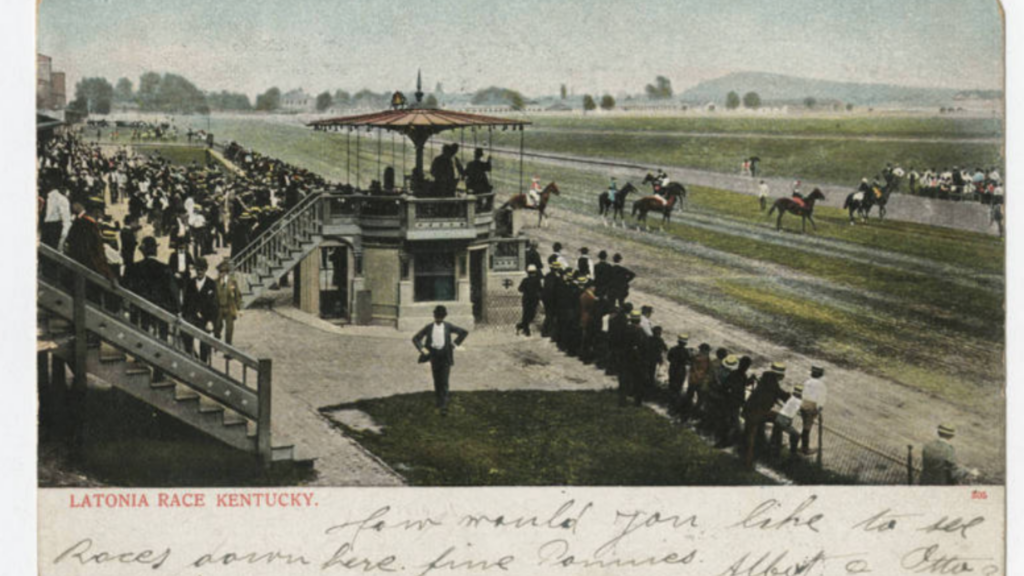
Courtesy of KY Historical Society
Unfortunately, after a few changes of ownership, things slowed down soon after the Great Depression started, and it was abruptly sold in 1939 to Standard Oil of Ohio, which dismantled the track and built an oil refinery on site.
Twenty years later, another group of northern Kentucky horsemen — this time led by Matt Winn Williamson, grandson of Col. Matt Winn, who had ties to Churchill Downs — decided to open another track about 12 miles away from the former site of Latonia, this time closer to Florence, Kentucky.
The men kept the name somewhat the same — Latonia Race Course — but most people in the area referred to it as the "New Latonia." Thoroughbred racing thrived once again here, but with more changes of ownership and declining infrastructure, the track fell out of favor in the 1970s and 1980s.
Finally, in 1986, businessmen Jerry Carroll and James Thornton purchased the track and renamed it Turfway Park . Millions have since been put into the facility for upgrades, and although it has changed hands since then (it is now owned by Churchill Downs), horse racing has been going strong at Turfway with fall, holiday and spring meets.
Turfway is currently under a $145 million renovation, and when it reopens in the summer of 2022, it'll be called Turfway Park Racing & Gaming. In addition to a new clubhouse and synthetic and dirt tracks, nearly 1,500 gaming machines will be added to the facility.
Horse Racing in Kentucky Today
There are now five thoroughbred racing tracks and three harness racing tracks in Kentucky. The five tracks include Churchill Downs (Louisville), Keeneland Race Course (Lexington), Turfway Park (Florence), Kentucky Downs (Franklin) and Ellis Park (Henderson).
The three harness tracks include The Red Mile (Lexington), Bluegrass Downs (Paducah) and Thunder Ridge Raceway (Prestonburg).
We mentioned these two facts in the beginning, but they're worth repeating. According to the KTA, the equine industry generates $6.5 billion in annual economic activity and provides more than 60,000 jobs in Kentucky.
Here are a few more eye-opening horse racing statistics, courtesy of the KTA:
- 111 out of 145 Kentucky Derby winners were Kentucky-bred
- 10 out of 13 Triple Crown winners were Kentucky-bred
- The thoroughbred industry is responsible for $115 million in tax revenues for Kentucky.
- There are more than 238,000 horses in Kentucky, about one horse for every 18 people.
- There are 77 horse-related attractions in Kentucky.
- Horse-racing operations have a $517 million direct impact on Kentucky's economy.
- The 2019 Kentucky Derby and Oaks had an economic impact of more than $356 million.
Kentucky is also home to hundreds of horse farms where thoroughbreds are born, raised, trained and even retired. Some of the biggest ones include Ashford Stud (American Pharoah, Justify); Calumet Farm (Whirlaway, Citation); Claiborne Farm (Secretariat, Bold Ruler); Three Chimneys Farm (Seattle Slew); Old Friends Equine (retirement farm); and the Kentucky Horse Park (tourist attraction).
Thousands of tourists visit Kentucky each year looking for up-close-and-personal experiences with race horses, whether that's betting at the track or visiting one of these many Kentucky horse farms for a backside tour.
Mint Julep Experiences recognized early on the passion and enthusiasm for the horse industry in Kentucky, and they proudly offer horse-farm excursions in addition to pit stops along the Kentucky Bourbon Trail®. Through custom tours , you can create your ideal itinerary with a mix of bourbon distilleries and thoroughbred farms, or just focus strictly on the equine industry. It's all up to you.
Book your bucket list trip now and let's horse around in Kentucky!
Request Custom Horse Country Tour

Source: https://mintjuleptours.com/2021/07/30/the-history-of-horse-racing-in-kentucky/
Post a Comment for "What is the Oldest Continuous Horse Race in Kentucky"